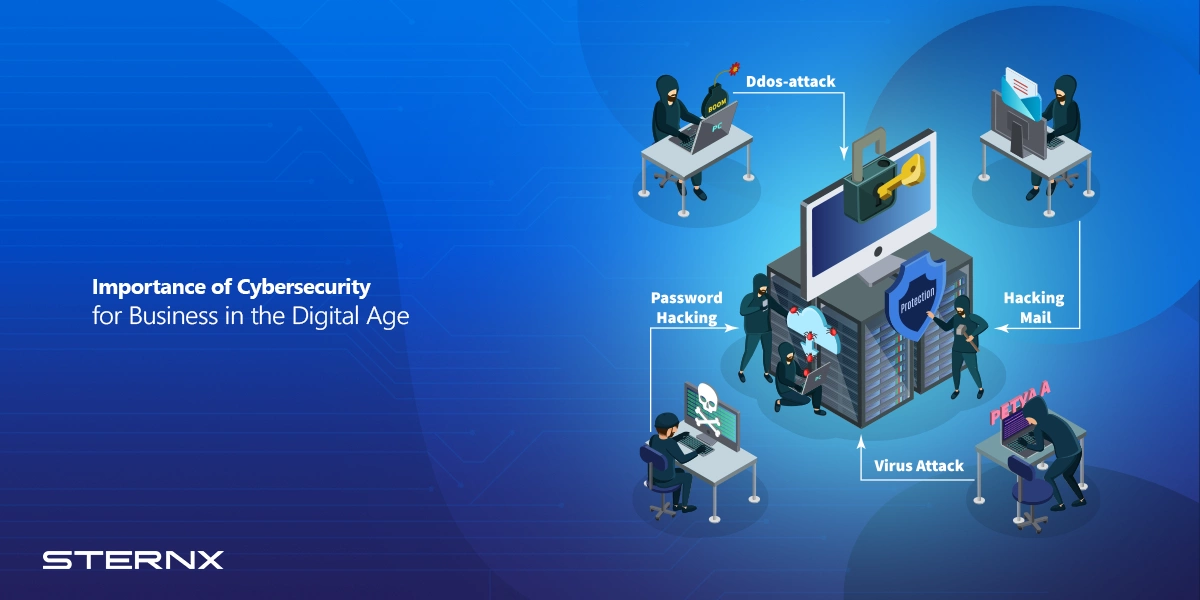Businesses rely heavily on digital technologies, and the importance of cybersecurity for business cannot be overstated. As our reliance on technology grows, so do the risks associated with cyber threats. Cybercriminals are becoming increasingly sophisticated, and their attacks can have devastating consequences for businesses of all sizes. The statistics are alarming – according to the Ponemon Institute’s 2022 Cost of a Data Breach Report, the average cost of a data breach for a U.S. company is a staggering $9.44 million. Cybersecurity is no longer an option, it’s a necessity for any business that wants to protect its assets, reputation, and long-term viability.
Table of Contents
ToggleEvolution of Cyber Threats:
The cyber threat landscape has evolved rapidly over the years, with cybercriminals constantly developing new techniques and exploiting emerging vulnerabilities. From the early days of viruses and worms to the more recent phishing emails, ransomware attacks, and advanced persistent threats (APTs), the challenges faced by businesses have become increasingly complex.
Common Types of Cyber Attacks:
Today, businesses encounter various cyber threats like phishing attacks, malware infections, distributed denial-of-service (DDoS) attacks, SQL injection attacks, and social engineering tactics. These threats can result in data breaches, financial losses, system downtime, and reputational damage, underscoring the importance of data breach prevention in business.
Impact of Cyber Attacks on Businesses:
Cyber attacks pose a significant threat to businesses, leading to financial losses, reputational damage, and disruptions in operations. Understanding the impact of these attacks is crucial for businesses to develop robust cybersecurity strategies and protect their assets.
Financial Implications:
The financial impact of a cyber attack can be devastating for businesses. In addition to the direct costs associated with incident response, data recovery, and potential regulatory fines, businesses may also face indirect costs such as lost productivity, diminished customer trust, and damage to their brand reputation. According to the Ponemon Institute’s report, the average cost of a data breach for a U.S. company increased by 2.6% from 2021 to 2022, highlighting the escalating financial burden of cyber threats.
Reputational Damage:
A successful cyber-attack can severely tarnish a business’s reputation, causing significant damage to its brand and customer trust. In today’s digital age, where news travels fast and consumers are increasingly conscious of data privacy and security, a data breach or network security incident can quickly erode a company’s credibility and market standing.
Legal and Regulatory Consequences:
Businesses operating in regulated industries or handling sensitive data may face legal and regulatory consequences in the event of a cyber-attack. Non-compliance with data protection regulations, such as the General Data Protection Regulation (GDPR) or the California Consumer Privacy Act (CCPA), can result in hefty fines and legal penalties. Additionally, businesses may face lawsuits from affected customers or partners, further compounding the financial and reputational consequences.
Role of Cyber Security in Business Operations:
Protection of Sensitive Data:
One of the primary roles of cybersecurity is to protect sensitive data, risk mitigation, including customer personal data, intellectual property, and financial records. Businesses handle vast amounts of critical data, and a breach can have severe consequences, such as identity theft, financial fraud, or the loss of competitive advantage.
Security for Networks and Infrastructure:
Cybersecurity important measures are essential for protecting your business networks, systems, and infrastructure against unauthorized access, data theft, and malicious activities. Robust security protocols, firewalls, and intrusion detection systems are crucial for maintaining the integrity and availability of business operations.
Ensuring Continuity of Business Operations:
Cyber-attacks can disrupt business operations, leading to significant downtime, lost productivity, and revenue losses. Effective cybersecurity measures help ensure the continuity of business security operations by mitigating cybersecurity risks of system failures, data breaches, and other cyber incidents.
Strategies for Implementing Cyber Security:
Risk Assessment and Management:
The first step in implementing a robust cybersecurity strategy is to conduct a comprehensive risk assessment. This involves identifying potential threats, security vulnerabilities, and the likelihood of their occurrence. Based on this assessment, businesses can develop an effective risk management plan with security teams that prioritizes the implementation of appropriate security controls and countermeasures.
Employee Training and Awareness:
Human error is often a significant contributing factor in cyber-attacks, making employee training and awareness a critical component of any cybersecurity strategy. The importance of employee training in cybersecurity programs and security awareness campaigns can help employees recognize and respond appropriately to potential threats, such as phishing attempts or social engineering tactics.
Utilization of Encryption and Authentication Measures:
The role of encryption in business cybersecurity and authentication measures are essential for protecting sensitive data and ensuring secure communication within and outside the organization. Implementing strong encryption protocols, multi-factor authentication, and secure access controls can significantly reduce the risk of data breaches and unauthorized access.
Compliance and Cyber Security:
Standards and Regulations:
Businesses operating in various industries and regions must comply with relevant cybersecurity standards and regulations. Examples include the Payment Card Industry Data Security Standard (PCI DSS) for businesses handling credit card transactions, the Health Insurance Portability and Accountability Act (HIPAA) for the healthcare industry, and the GDPR for organizations operating in the European Union.
Ramifications of Non-Compliance:
Non-compliance with cybersecurity standards and regulations can have severe consequences for businesses. In addition to potential fines and legal penalties, non-compliance can also damage a company’s reputation, lead to loss of customer trust, and hinder its ability to operate effectively in certain markets or industries.
Best Practices for Cyber Security:
It is very important to follow the best practices of cyber security in other to protect your business from security vulnerabilities. Here are some key cyber security best practices to follow:
Regular Software Updates:
Keeping software regularly updated, operating systems, and firmware up-to-date with the latest security patches and updates is crucial for mitigating known vulnerabilities and reducing the risk of cyber-attacks and prevent data breaches. Businesses should establish a robust patch management process to ensure timely and consistent software updates across their IT infrastructure.
Strong Password Policies:
Implementing strong password policies and encouraging the use of multi-factor authentication can significantly enhance the security of user accounts, confidential information, and prevent unauthorized access. Businesses should educate employees on best practices for creating and managing secure passwords, and consider deploying password management solutions to facilitate compliance.
Backup and Recovery Plans:
In the event of a cyber-attack or data loss incident, having a well-defined backup and recovery plan can minimize the impact on business operations. Regular data backups, coupled with tested recovery procedures, can help businesses quickly restore critical systems and data, minimizing downtime and associated costs.
Technologies and Solutions:
Firewalls and Intrusion Detection Systems:
Firewalls and intrusion detection systems (IDS) are essential components of a comprehensive cybersecurity strategy. Firewalls act as a barrier between an organization’s network and the internet, filtering and monitoring incoming and outgoing traffic based on predefined security rules. IDS systems, on the other hand, monitor network activity and alert administrators to potential security breaches or malicious activities.
Endpoint Security Solutions:
Endpoint security solutions protect devices such as laptops, desktops, and mobile devices from cyber threats. These solutions typically include antivirus software, anti-malware protection, and other security features designed to detect and prevent malicious activities at the endpoint level.
Security Information and Event Management (SIEM):
SIEM solutions collect and analyze security-related data from various sources within an organization, such as firewalls, intrusion detection systems, and other security tools. By consolidating and correlating this data, SIEM solutions can provide real-time visibility into potential threats, enabling faster incident response and better threat intelligence.
Emerging Trends and Future Challenges:
Artificial Intelligence in Cyber Security:
The integration of artificial intelligence (AI) and machine learning (ML) technologies into cybersecurity solutions is a rapidly emerging trend. AI and ML can enhance threat detection, pattern recognition, and automated response capabilities, potentially providing a more proactive and adaptive approach to cybersecurity.
Internet of Things (IoT) and Security Risks:
The proliferation of Internet of Things (IoT) devices, ranging from smart home appliances to industrial control systems, introduces new security challenges. Many IoT devices lack robust security features, making them potential entry points for cyber-attacks. As the IoT ecosystem continues to expand, businesses must prioritize the secure implementation and management of these devices.
Conclusion:
Cybersecurity is no longer an optional consideration for businesses, it’s an essential component for survival and success. The cyber threat landscape is constantly evolving, and the consequences of a successful attack can be devastating, including financial losses, reputational damage, and legal implications.
Implementing a robust cybersecurity strategy involves a multifaceted approach, encompassing risk assessment, employee training, encryption and authentication measures, compliance with industry standards and regulations, and the adoption of best practices such as regular software updates, strong password policies, and backup and recovery plans. Businesses should leverage advanced technologies and solutions, including firewalls, intrusion detection systems, endpoint security solutions, and security information and event management (SIEM) systems, to enhance their cybersecurity posture.
As emerging trends like artificial intelligence and the Internet of Things (IoT) continue to shape the cybersecurity landscape, businesses must remain vigilant and adapt their strategies to address evolving challenges.
By prioritizing cybersecurity and proactively implementing measures to protect their digital assets, businesses can safeguard their operations, protect customer data, and ensure long-term sustainability in an increasingly connected and cyber-threatened world.


